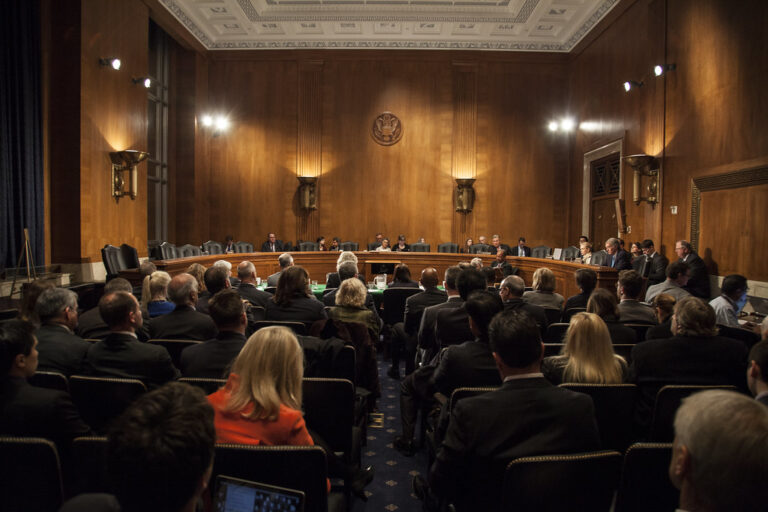
Sharon Block is a Professor of Practice and the Executive Director of the Center for Labor and a Just Economy at Harvard Law School.
Yesterday, President Trump nominated Brett Kavanaugh to replace retiring Justice Anthony Kennedy on the Supreme Court. Kavanaugh currently serves as a judge on the United States Appeals Court for the District of Columbia Circuit. He was nominated to the D.C. Circuit by President George Bush in 2003 but was not confirmed until 2006. Prior to coming to the bench, Kavanaugh held a number of positions that brought him into the partisan fray, including serving on Ken Starr’s Whitewater Special Counsel team, working for President Bush on the Florida recount, and serving in the Bush White House as the staff secretary. He clerked for Justice Kennedy, overlapping with Justice Gorsuch’s tenure in Kennedy’s chambers. He attended Yale University for both college and law school.
Kavanaugh’s nomination was met with swift and strong opposition from the labor movement. AFL-CIO President Rich Trumka described Kavanaugh as having a “dangerous track record protecting the privileges of the wealthy and powerful at the expense of working people.” SEIU tweeted that “confirming Kavanaugh would tip the scales of justice against working people.”
Opposition to the nomination by the labor movement is no surprise. Kavanaugh’s record demonstrates consistent support for the interests of employers and a lack of concern for the interests of workers and the government agencies that come to the D.C. Circuit to protect workers’ rights. Below, I will provide an overview of his record and attempt to make the case that his record reflects a sustained and, at times, aggressive hostility to the role of the law in protecting the vulnerable and less powerful.
An appropriate starting point in conveying the character of his record is his dissent in Agri Processor Co., Inc. v. NLRB. There, the majority held that the employer had a duty to bargain with its employees, despite the fact that many of the employees were undocumented workers. The majority relied on the Supreme Court’s holdings in Hoffman Plastic Compounds and Sure-Tan that undocumented workers were “employees” covered by the NLRA. Despite the Supreme Court’s decision in Hoffman, Kavanaugh dissented, denying that either Hoffman or Sure-Tan resolved the question of the Act’s coverage for undocumented workers. The majority held that the argument offered by the employer and supported by Kavanaugh “ignores both the Act’s plain language and binding Supreme Court precedent.”
The Agri Processor dissent is significant for a number of reasons. First, it reflects a broader trend in Kavanaugh’s record of being unsympathetic to the plight of immigrants. The National Immigration Law Center cautioned that “Kavanaugh’s legal writings and recent dissents speak for themselves: he thinks immigrant communities should be Constitution-free zones . . . .” I would note too that while the Agri Processor majority refers to the workers at issue in the case as “undocumented workers” or “aliens without work authorization,” Kavanaugh adopts the label reviled by advocates for immigrants, “illegal immigrant workers.” Second, as discussed in greater detail below, his dissent reflects a willingness to write groups of workers completely out of basic labor standards – here all undocumented workers out of the basic right to engage in collective bargaining.
Finally, and in some ways most important, the Agri Processor dissent raises serious questions about Kavanaugh’s respect for precedent. Sitting as a court of appeals judge in Agri Processor, Kavanaugh was bound to follow the Supreme Court’s holding in Hoffman Plastic. His view that this decision left open the question of whether undocumented workers were “employees” under the Act runs counter to a stark fact about Hoffman. In Hoffman, the Supreme Court holds that undocumented workers are not entitled to back pay awards under the National Labor Relations Act. But the Court also explicitly holds that other remedies are available when an employer violates the NLRA rights of an undocumented worker. As the Supreme Court put it in Hoffman, “[l]ack of authority to award backpay does not mean that the employer gets off scot-free.” Indeed, the Hoffman Court goes on to hold that the employer “will be subject to contempt proceedings should it fail to comply with these orders,” and that such remedies – including contempt sanctions – are “sufficient to effectuate national labor policy.” Of course, if undocumented workers are not employees, there would be no remedies available in a case like Hoffman. The fact that the Supreme Court goes out of its way to affirm that remedies are available in cases involving undocumented workers – and writing that such remedies effectuate national labor policy – is simply inconsistent with a holding that undocumented workers are not employees. That Kavanaugh would have held as much as a court of appeals judge raises questions about how as a Justice he would treat controlling precedent with which he disagrees.
Looking more broadly at Kavanaugh’s record reinforces the themes present in the Agri Processor dissent. In his 12 years on the bench, Kavanaugh frequently sided with employers in the numerous NLRB cases that came before him, including in several high profile cases. For example:
- In NLRB v. CNN America Inc., when CNN brought approximately 300 union-presented technical positions in-house after having contracted out those positions for many years, Kavanaugh joined the majority in finding that CNN was not a joint employer with contractor, but dissented from the finding that CNN was a successor employer. Kavanaugh’s position would have completely absolved CNN of any liability for failing to abide by the collective bargaining agreement.
- In Southern New England Telephone Co. v. NLRB, Kavanaugh wrote the majority opinion allowing the employer to prohibit workers from wearing pro-union t-shirts when dealing with customers. He began his opinion by accusing the NLRB of lacking “common sense.”
- In Verizon New England v. NLRB, Kavanaugh again wrote a majority opinion rejecting protection for employees who expressed pro-union sentiments during a labor dispute. Kavanaugh held that Verizon could prohibit workers from displaying pro-CWA signs in their cars parked on Verizon’s property and in view of the public. The majority held that the collective bargaining agreement’s waiver of the right to picket encompassed a waiver of the right to display the signs.
- InVenetian Casino Resort v. NLRB, Kavanaugh wrote the majority opinion reversing the Board’s decision that the Venetian violated the Act when it called the police to remove union demonstrators who were trying to organize the Venetian’s workers. The majority held that the Venetian’s call to the police constituted a petition to the government, shielded from liability by the First Amendment by the Noerr-Pennington doctrine.
What stands out about Kavanaugh’s record in labor cases is not just his consistency in ruling for employers over workers, but the seemingly unnecessary positions he sometimes takes when doing so. Below is an overview of those cases – in addition to Agri Processor — that demonstrate Kavanaugh’s more anti-worker/pro-employer tendencies:
- In American Federation of Government Employees v. Gates, the court reviewed regulations issued by the Bush Administration’s Department of Defense implementing a statute that gave DOD the authority to temporarily impose a new labor management system for DOD’s career employees. Kavanaugh’s majority opinion held that the Secretary of Defense was empowered to abolish collective bargaining altogether. As the dissent points out, Kavanaugh reached this conclusion despite the fact that: (1) the authorizing statute explicitly stated that DOD was required to “ensure that employees may . . . bargain collectively,” and (2) DOD did not even argue to the court that it had the authority to abolish collective bargaining – instead DOD argued for flexibility in creating the new system.
- In Miller v. Clinton, Kavanaugh argued to remove a group of employees from the protection of the anti-discrimination statutes. In that case, the State Department conceded that it had fired a worker employed abroad expressly because of his age – imposing mandatory retirement for employees who reached sixty-five. The majority rejected the State Department’s position. Kavanaugh dissented, holding that the State Department was free to impose a mandatory retirement age. The majority noted – and Kavanaugh did not disagree – that Kavanaugh’s position would free the State Department from “any statutory bar against terminating an employee like Miller solely on account of his disability or race or religion or sex.” Kavanaugh argued that workers’ rights under constitution were sufficient to protect them from discrimination on the basis of race, sex and religion, even as he conceded that they would be entitled only to equitable remedies without the protection of the federal anti-discrimination statutes and have no protection from age discrimination.
- Seaworld of Fla., LLC v. Perez involved the death of a worker who trained killer whales who performed for the public at the theme park. One of the performing whales dragged the trainer under the water and drowned her during a performance. The record showed that killer whales at Seaworld had killed three trainers previously. The Occupational Safety and Health Administration had found that Sea World failed to take the necessary steps to protect trainers from the known hazard posed by close contact between trainers and killer whales. The majority agreed that ample evidence supported OSHA’s citation. Kavanaugh dissented, questioning the basic premise of OSHA’s mission to determine appropriate levels of risk for workers. He accused OSHA of “paternalistically” deciding whether entertainers must be protected from themselves. Instead, he argued, employers – at least those who provide public entertainment – should be free from addressing known risks for their workers and workers should decide whether they think the risks are worth undertaking. He argued that the majority’s decision would lay a foundation for OSHA outlawing NASCAR races and NFL games.
Labor unions and their progressive allies already have pledged to wage a fierce campaign against Kavanaugh’s confirmation. As many of the headlines about the nomination note Kavanaugh’s strong pro-business stance (see here and here and here), we should expect that much of the debate over confirmation will focus not only on abortion and LBGTQ rights, but also on labor and employment issues.






Daily News & Commentary
Start your day with our roundup of the latest labor developments. See all
November 25
In today’s news and commentary, OSHA fines Taylor Foods, Santa Fe raises their living wage, and a date is set for a Senate committee to consider Trump’s NLRB nominee. OSHA has issued an approximately $1.1 million dollar fine to Taylor Farms New Jersey, a subsidiary of Taylor Fresh Foods, after identifying repeated and serious safety […]
November 24
Labor leaders criticize tariffs; White House cancels jobs report; and student organizers launch chaperone program for noncitizens.
November 23
Workers at the Southeastern Pennsylvania Transportation Authority vote to authorize a strike; Washington State legislators consider a bill empowering public employees to bargain over workplace AI implementation; and University of California workers engage in a two-day strike.
November 21
The “Big Three” record labels make a deal with an AI music streaming startup; 30 stores join the now week-old Starbucks Workers United strike; and the Mine Safety and Health Administration draws scrutiny over a recent worker death.
November 20
Law professors file brief in Slaughter; New York appeals court hears arguments about blog post firing; Senate committee delays consideration of NLRB nominee.
November 19
A federal judge blocks the Trump administration’s efforts to cancel the collective bargaining rights of workers at the U.S. Agency for Global Media; Representative Jared Golden secures 218 signatures for a bill that would repeal a Trump administration executive order stripping federal workers of their collective bargaining rights; and Dallas residents sue the City of Dallas in hopes of declaring hundreds of ordinances that ban bias against LGBTQ+ individuals void.